#burrows into the ground
Explore tagged Tumblr posts
Text
my persistent and long-running fandom fear is once again rearing its head 😩
#personal bullshit#please brain can we not deliberately shit the bed for one day?#burrows into the ground#yes#i know i'm a loser with nothing better to do in life except ruminate about dumb shit
24 notes
·
View notes
Text
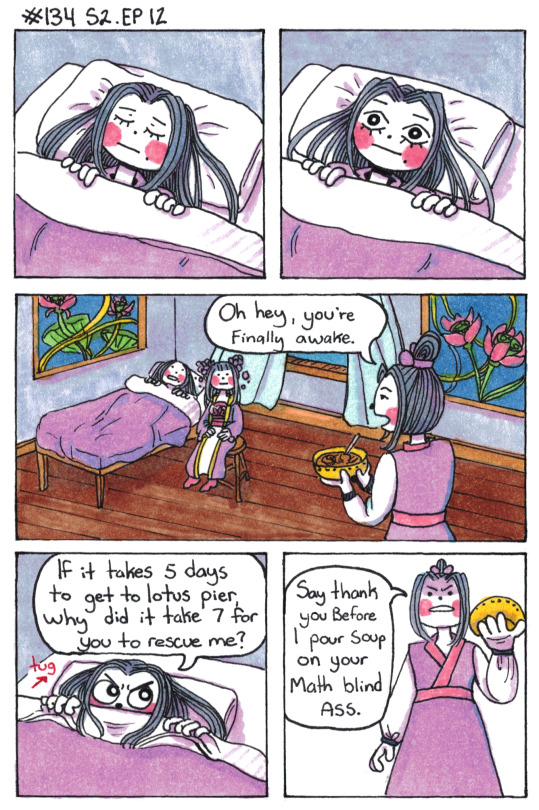
Good Morning, World.
[First] Prev <–-> Next
#poorly drawn mdzs#mdzs#wei wuxian#jiang yanli#jiang cheng#'Good Morning World' because to wwx the jiang household is what grounds him. It is his burrow and blanket.#The familiar soup and banter is his home. The familiar arguments and tension are also his home.#Notice how quickly he throws LWJ to the side once he has JC back in reach! 'He was so boring; I wish *you* were there!'#WWX is very quick to constantly remind himself that he fits within a very specific power structure and role.#He pushes boundaries but almost always only the boundaries that he knows he can push against.#Sitting here now and realizing that if WWX did take life more seriously and act more diligent he would totally usurp JC.#Because the contrast with Them (tm) is wwx is the one that gets in trouble and JC is the one that sticks to the rules.#That responsible appearance especially in contrast is the thin line that holds JC's self-esteem together.#And lets be fully honest. From JC's perspective the last week was also extremely intense and stressful.#It truly was a feat to travel so far so fast despite also being exhausted. Never knowing if it is all in vain.#JC said with his actions 'I would move mountains for you and dig through stone with my bare hands if it meant reaching you.'#and WWX said '[read]'#It's about wwx chronically asking 'why would someone care for me? I'm always tool to be used' than accepting that people love him.
2K notes
·
View notes
Text

Few people are aware that giant ground sloths created equally giant burrows, large enough for a grown man to stand in.
5K notes
·
View notes
Text

in all seriousness i am going to get this pic tattooed to the back of my eyelids. does anyone know any people or
#lovely truly#/j ofc but still#maybe a 10ft banner?? hmmm#also /j i am broke#joe burrow#ja'marr chase#ALSO not to be insane i was so fucking high from the 911 latest ep and got sent#crashing down to the ground by the thing that i won’t say happened LMAOOOOO life is a chocolate bar made of acid or however the saying goes#joemarr
106 notes
·
View notes
Text
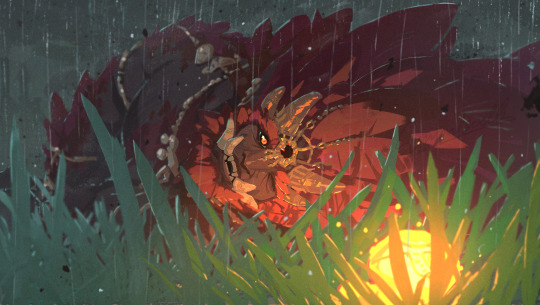
rough concept for the cutscene between phase 3 (beast ganondorf, design not final) and the final fight
(totk rewritten project)
(.. i really need to find an approach to painting these that i like, i dont think its very convincing .. and it wasnt very fun to paint either :( )
#ganondoodles#zelda#art#totk#ganondoodles rewrites totk#ganondorf#dare i say i actually kinda hate it fkrdnhfkdn#it looks way too flat and neither pretty enough nor convincing#there are some people out there able to paint in a really pretty stylized way and yet it looks like a real screenshot#i gotta figure out what im doing wrong#thank god these are just some concepts#i imagined this scene to be rly cool#at beggining of phase 3 he burrows throw the ground with them and they all fight on the surface#at the end of it zelda tells link to shoot an arrow at her#and the deflect it with her light shield#and it shoots off the stone on gans head#he goes down and zelda makes a run for the stone#but in a last desperate attempt to avoid being imprisoned again (despite not zelda nor link wanting that)#gan lunges forward and eats the stone#cue the final fight
872 notes
·
View notes
Text
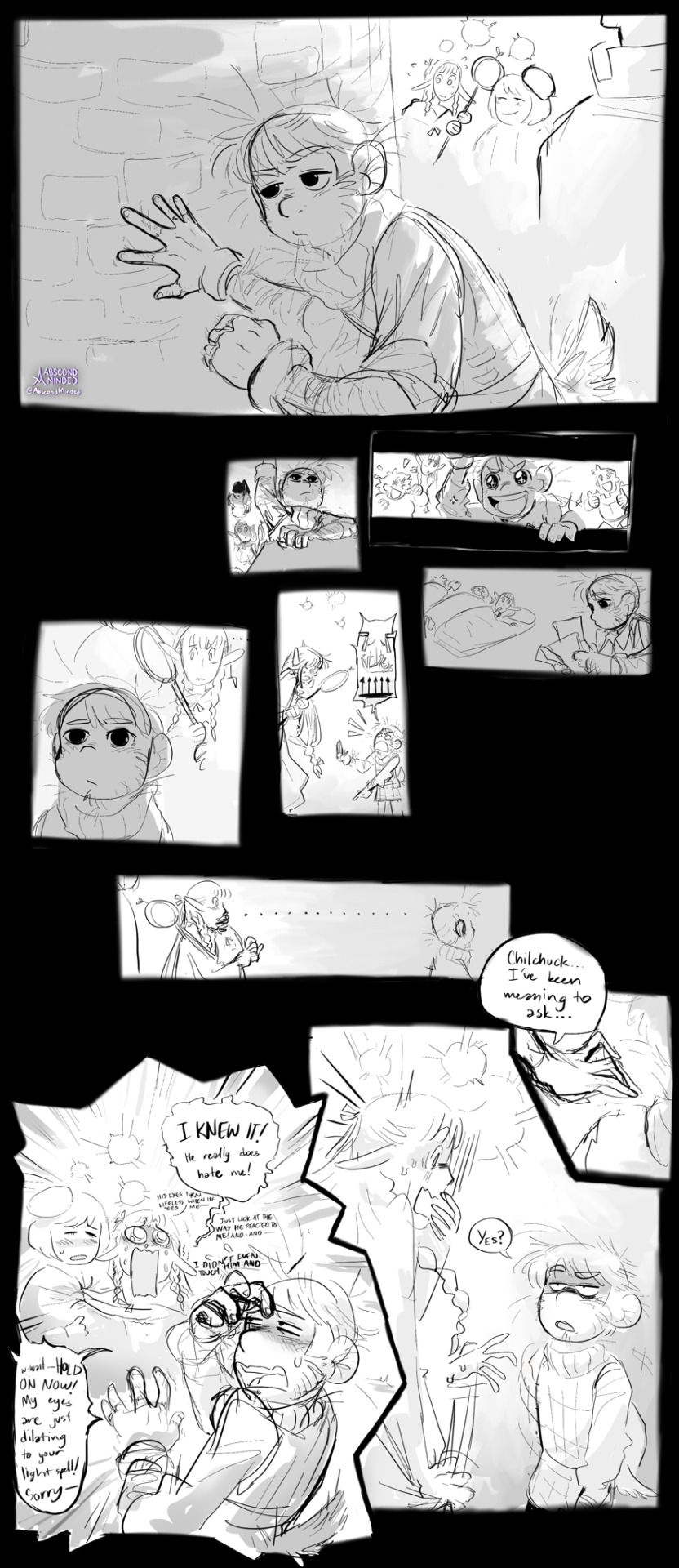
Silly little comic, close-ups of panels below the cut

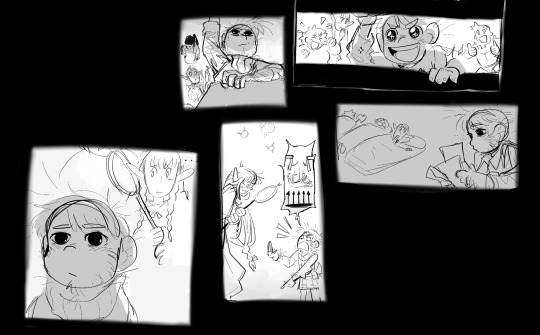
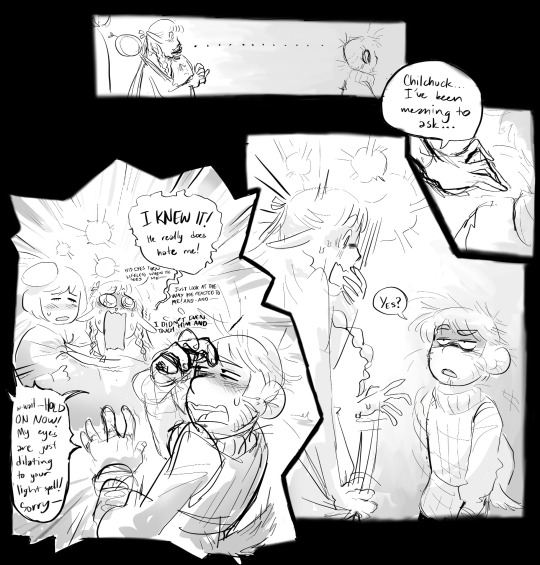
#fun little speculative evolution/biology stuff#I imagine half-foots being highly social and more active at dusk and night compared to other humans#many half-foot communities live low to the ground in tropical-temperate forested areas#some communities closer to dwarven towns choosing to burrow instead of remaining only above ground#burrowing half-foots tending to have shorter heights and tails compared to their above ground counterparts#they’d also more align to dwarven beauty standards compared to elven and tallmen (to an even higher degree)#chilchuck#marcille donato#chilchuck tims#dungeon meshi#delicious in dungeon#fanart#myart#comic#I don’t think chilchuck would be strictly a burrowing half-foot but he’d have a lot of the traits of them that helps him explore dungeons
220 notes
·
View notes
Text
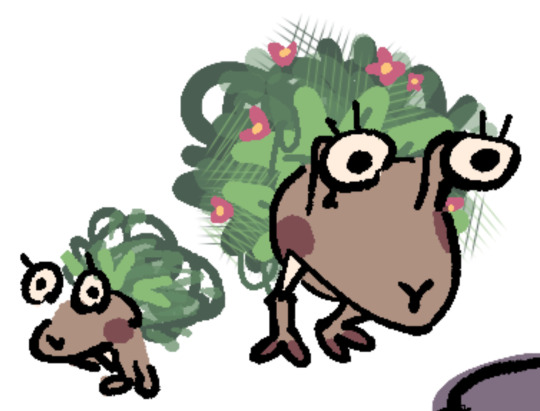
PIKMIN FAN ENEMY: leafy Bulborb (and juvenile)
#funky!art#pikmin#pikmin fan enemy#? is that a thing#they basically function like normal Bulborbs except they burrow in the ground. the juvenile ones are fully hidden and crawl out when you get#near like sheargrubs or whatever. and the adult one is sort of like the emperor bulblax where the eyes and a bit of leaves are out of the#ground. But less health than emperor/acts like normal adult Bulborb LOL. also they’re cute Smile
430 notes
·
View notes
Text

some sort of creature
#i finally figured out how to adjust brush pressure sensitivity so im trying to get a feel for it to see if i like it#theyre very shy.. burrows into the ground to escape social interactions which honestly i wish i could do too#now that i think about it i have a soft spot for shy characters but like not in a uwaaahhh >m< way. like they become the most sopping wet#creature alive if u ask them to make a phone call. they will look at u so betrayed if u asked them to talk to the mcdonalds cashier etc etc#i havent read chainsaw man but i feel like im describing kobeni based on what ive seen of her and i have to agree#moles are also like this because ummm. because they live in the dirt and dont talk to anyone and have shitty eye sight like me#my art#myart#doodles#sona#fursona#mulch#fur#furry art
214 notes
·
View notes
Note
*raises hand*
does nightmare moon ouccur in this fancy lore version of mlp? if so, how?
Yes, and there is an area of equestria with craters from stomping hooves and a massive valley where one of the goddesses was thrown to the earth. It's a fertile river valley now with a huge blooming city (idk which city. pick one for me)
I havent decided if the battle is going to be a painting or a fic, but I made a playlist that will inspire me when I do get to it.
These songs are picked on vibe rather than lyrics.
Please picture you are a pony watching the sky catch fire and burn, darkened by choking, star-filled smoke, split with sunbeams that char the ground on which they hit. None of it is aimed at you. None of it is aimed at the village where your father lives. None of it is meant to destroy the land or leave chasms where there were once people.
The gods aren't angry with you. But there is a hole where there used to be a town. You know no one survived.
As they cast beams of magic into the sky that rip the atmosphere to shreds, you wonder if the next earthquake will land closer or further from the place where you stand.
You close your eyes and pray it takes you next.
It includes at least one song from an MLP au that I don't know anything about except that the music SLAPS. And that's Infinite Eclipse songs by JC Rowss
#ask#shire draws mlp#skyscraper gods lore#skyscraper gods#ssg path#like when you are the size of a mountain you cant just slam your sister into the ground#imagine two giant monster trucks with flame throwers#duking it out on a meadow filled with small trees and tiny creeks and acres upon acres of burrows and nesting birds#mad max doesn't care that it crushed an entire flock of quail#its too busy playing fire-guitar
522 notes
·
View notes
Text

The galdur are coming in real nice this time of year.
16 notes
·
View notes
Text
Scientists Buzzing After Unique Native Bee Colonies Discovered Right on Their College Campus https://www.goodnewsnetwork.org/scientists-buzzing-after-unique-native-bee-colonies-discovered-right-on-their-college-campus/

“””In a charming coincidence, a pair of bee and insect specialists from Washington College are buzzing with excitement about a unique and newly documented population of native bees right on their very own campus.
Although the large group of ground-nesting bees has been noticeable on one corner of the campus for years, recent identification of at least five different species all using the same area has sparked interest from researchers.
The section of the college green located in front of East and Middle Halls is a hotspot for these vital pollinators, with ground-nesting ‘mining’ bees from the Andrena and Colletes genera thriving on the hill at the base of the halls.
Recently, thanks to her keen eye and love of insects, photographer Pamela Cowart-Rickman realized that the area has multiple species of native mining bees all nesting together, something that has not been well documented.
Cowart-Rickman, who studied biology at WC as an undergrad and developed a love of insects has tentatively identified five different species that are all sharing the same nesting grounds. They include four different Andrena (mining bees), one Colletes (cellophane bees), and likely three cuckoo bees in the genus Nomada.
The Washington College site provides rare nesting habitat for multiple native bee species, several of which are uncommon and unidentified,” said Sam Droege from the US Geological Survey’s Bee Lab.
“We always talk about providing plants to support native bees and other pollinators, but we rarely think about providing adequate nesting habitat for their survival. These native bees provide beneficial pollination to fruiting trees and plants, not only on the College campus, but also the Chestertown community.”
“They have been nesting amongst and on top of each other for several years in this same location,” said Cowart-Rickman of the bees she has spotted. “The various Andrena have the largest nesting area and emerge first in late February. The Colletes have a smaller area and emerge later in late April.”
Cowart-Rickman devotes her free time to photographing insects and has been helping researchers identify and track populations. She has found and documented several species for MD Biodiversity, BugGuide, iNat, and researchers at the Canadian National Collection of Insects.
When she realized what she had stumbled upon right outside her own office building on campus, she reached out to Dr. Beth Choate, deputy director of the Washington College Center for Environment and Society. Choate, who has published research on the abundance of wild bee populations in urban and rural gradients, was also intrigued by the nesting sites Cowart-Rickman had found. The two decided to investigate further.
“On a nice day in the spring, you can see the male bees hovering right at grass level. There were hundreds of these males searching for a female to mate when we were out there,” said Choate.
Females create a small burrow in the ground for rearing young and a ball of pollen and nectar is placed in each to feed the larval bee when it emerges from the egg, Choate explained. Once the males and females mate, the female returns to her nest and lays the egg in the carefully constructed burrow to develop.
“Ground-nesting bees need bare, minimally covered ground in order to dig into the soil. They also prefer sunny and well-drained soil, but it will be interesting to learn what is unique about the soil in this space and why the aggregation has become so large,” said Choate.
“Since ground-nesting bees are solitary and do not form colonies, they generally aren’t as noticeable as this aggregation. Females often create nests near one another; however, an aggregation this large is unique.”
After seeing one of Cowart-Rickman’s nesting bee photos on iNat, and realizing the rarity of the site, Dr. Jordan Kueneman, a researcher with Project GNBee who is working on tracking ground-nesting bees at the Danforth Lab at Cornell University, reached out to Cowart-Rickman about possibly providing further research samples and information.
“We were very excited to learn about the ground-nesting bee aggregations at Washington College, for a myriad of reasons,” said Kueneman. “First, the size of the aggregation is substantial, and multiple species are utilizing areas of the overall site to nest. This scenario is ideal for understanding nesting requirements for bees and how those vary by species.
“Second,” Kueneman continued, “intermixed aggregations of nesting bees are particularly interesting to study from an ecological perspective, as the cost/benefits of varying nesting strategies and behavior can be more easily studied, particularly in the context of phenology, nest architecture, and risk of parasitism.”
He noted that due to its location, the Washington College aggregation can easily provide the opportunity for students and the public to learn about the biology of ground-nesting bees and the value they provide to the environment. He is also hopeful that knowledge of the history of the area and the site’s management can help inform how ground management practices on campus have impacted the population in the past and provide opportunities to explore how current management will impact this population in the future.
Research and monitoring of the aggregation will continue as teams from both schools work together to study what makes this site so appealing to multiple species of bees.
#good news#environmentalism#science#environment#nature#bees#insects#animals#conservation#ground bees#ground nesting bees#burrowing bees
29 notes
·
View notes
Text
can't get over how much they need to separate player knowledge from character knowledge in burrow's end like i would come apart at the seams if that was me
#burrow's end#like??? what is read? what's a parade#i would be lying on the ground#nosebleeding and twitching
52 notes
·
View notes
Text
i was thinking some more about the wyrms and had a :O moment.. what if they had multiple necks like a hydra..
#the whole humanoid torso is technically just the head#if there were multiple then they could cover more ground in the burrow system#i do need them to be as weird as possible they're important to me#ice storm over kosa
31 notes
·
View notes
Text

Another sketch brought to you by #paleostream
A Lestodon waiting for the heat of the day to ease, just as the caiman next to it. The bigger the burrow the bigger the roommates.
442 notes
·
View notes
Text
.
#I wold lick Joe burrows spit off the ground if I could.#sorry ignore this#I needed to put this thought out in the world
7 notes
·
View notes
Text
a week of stressing and cleaning and packing and throwing out throwing out throwing out and what. 20 minutes and a very scared cat later not much has changed or happened yet. the person took some photos, checked some things, will return next week or in two weeks. repeat repeat repeat. nothing is certain: we might be able to get the amount we wanted - or, worse case scenario, nearly half less; we might be able to move out before christmas or maybe we won't be able to move out until february. I feel so overwhelmed with everything
#żmija gada#I'm just tired. first her and her drama and me caring again for no good reason and against all reason.#and now this#and so so many other things in between#I just want to dig a hole in the ground and burrow there and wake up in spring
27 notes
·
View notes